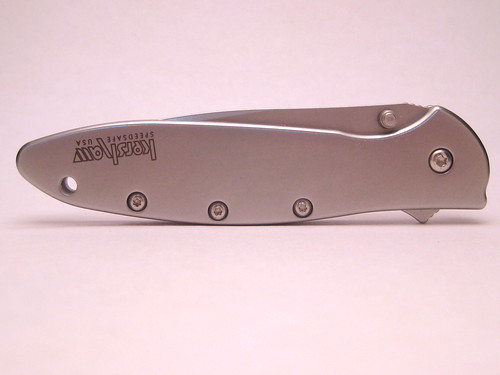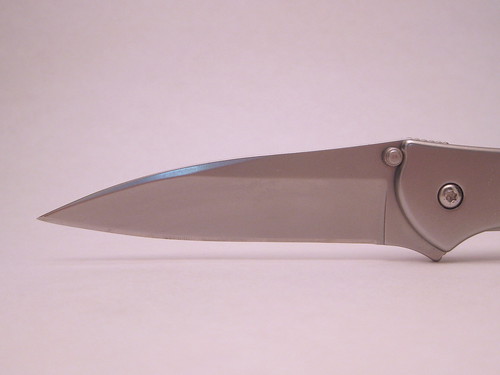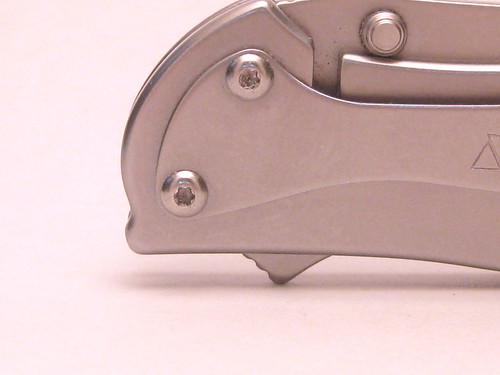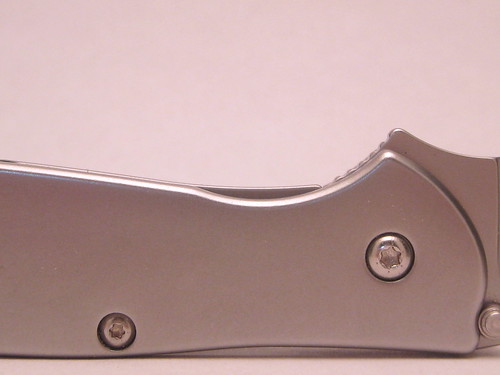Kershaw Leek Review
Virtually everyone on the planet has seen the Kershaw Leek. It has to be one of the best selling (if not THE best selling) knives of the past ten years. It is the Camry or Accord of pocket knives--it is reasonably priced, located in the middle of the market in terms of size, weight, and price, and it is sensibly decent with good steel and a utilitarian blade shape. Its not something that gets people excited, but it is quite good. In fact, its a sign that we are living an age of unparalleled quality gear that the Leek is merely decent. Its probably the best knife you can buy at Wal-Mart (I think the Skyline is better, but with the assisted opening and frame lock, the Leek has more bullets on its list of selling points) and that counts for a lot in today's market place.
Its mainstream chops could not be more solid, but the question for us, and this review, is whether it has any appeal to the enthusiast. In the end, I have to say that it does, but not quite as much as some other blades, including those in the Kershaw family. This is a good knife, but a boring one and one that has a serious flaw. If your a knife knut it could very well be your first "real" knife, but it has virtually no chance of being your last.
Here is the product page. The Leek costs around $50. There are roughly one bazillion variations with different blade steels, handle colors, blade finishes and even a reverse tanto version called the Random Leek (a mix of the original assisted opening knife, the Random Task and the Leek, both Ken Onion designs). Here is a written review. Here is a video review from the Late Boy Scout, one of my favorite YouTube reviewers. Here is a link to Blade HQ, where you can find the Leek, and all proceeds benefit the site when you purchase things through this link:
Blade HQ
Here is my review sample:
Twitter Review Summary: The Toyota Camry of the knife world has one major flaw...
Its mainstream chops could not be more solid, but the question for us, and this review, is whether it has any appeal to the enthusiast. In the end, I have to say that it does, but not quite as much as some other blades, including those in the Kershaw family. This is a good knife, but a boring one and one that has a serious flaw. If your a knife knut it could very well be your first "real" knife, but it has virtually no chance of being your last.
Here is the product page. The Leek costs around $50. There are roughly one bazillion variations with different blade steels, handle colors, blade finishes and even a reverse tanto version called the Random Leek (a mix of the original assisted opening knife, the Random Task and the Leek, both Ken Onion designs). Here is a written review. Here is a video review from the Late Boy Scout, one of my favorite YouTube reviewers. Here is a link to Blade HQ, where you can find the Leek, and all proceeds benefit the site when you purchase things through this link:
Blade HQ
Here is my review sample:
Twitter Review Summary: The Toyota Camry of the knife world has one major flaw...
Design: 2
Aesthetically, the Leek is so close to brilliance. The entire knife is one sleek piece of steel. I'd love to see an integral version (ridding the knife of unsightly screws) and I'd love to see the thumb stud go away and be replaced by an internal stop pin (they act as blade stops now), even with these two things I can't help but be impressed--this is a minimalist design from Ken Onion. That is a rarity, from a man that so loves curves and holes (yikes...paging Dr. Freud) that he made this knife. The look doesn't translate well as the Chive and Scallion seem runty, but here it is grace embodied. I'd get rid of the blade lock too, but that is a feature that is designed for someone other than the user, so it will probably stay ("Oh look, I got you this knife son. It even has a lock so it won't go off in your pocket. Thanks Dad.").
The Leek has the Golden Ratio for folding knives: 3:4:7 and 3. It has a three inch blade, a 4 inch handle, and an overall length of 7 inches and it weighs, in the frame lock incarnation, 3 ounces. The blade:handle is .75, which is quite decent and the blade:weight is 1, again very good. I didn't even need to bust out the calculator for those. Here is the Leek next to the Zippo:
The minimalist modern knife next to the timeless Zippo is quite a visual treat.
Fit and Finish: 2
After years of cranking these puppies out Kershaw has the Leek down to a science. There is nothing that is out of whack or weirdly finished. All of the edges are clean and smooth, except the one that isn't supposed to be. The jimping is minimally cut, but in this application (on a decidedly not hard use knife) that's fine. I actually like the texture of the flipper.
One thing I did notice though is that the flipper is, well, a bit lazy. Its not terribly fast, which I don't care about, and it is quiet (for a flipper), but it worries me. Its like the torsion bar is worn out or something. But I actually think this might be intentional. This is THE MAINSTREAM KNIFE after all, and what's less mainstream than a switchblade popping open? Nothing. I would imagine that Kai's engineers were told to make the "thwack" a little less "thwacky."
Grip: 0
Even for a non-hard use knife this thing is slick as snot. There is literally nothing to stop your hand from moving forward, even in the most low pressure cuts. I'd like a slightly more pronounced pre-pivot choil, or something else, anything really, to keep my hand from moving forward, but alas there is nothing. This is the single slickest knife I have ever seen, making the similarly dinged Cryo seem like a hand magnet.
Carry: 2
The slippery handle makes for wonderful carry. This knife glides in and out of the pocket, but the clip is substantial enough that it won't flop out. The knife is also super thin, adding to its vanishing powers.
Steel: 2
Dollar for dollar there might not be a steel I like more than Sandvik 14C28N. Slowly knives have begun trickling in from companies other than Kershaw that use this steel and I like it. I pounded the bejeesus out of it in my Fixed Blade Skyline and it held up fine. It also takes a villainous edge (there you go, the name for your knife company or knife store or your heavy metal band, just give me props) as seen here. Out of the box it craved to cut and after a resharpen it was still aggressive. It doesn't rust, mar, or stain even in the bead blasted finish seen here. Some folks liken 14C28N to a poor man's S30V. I think they are right on the account of price, but wrong on the account of performance. Personally, I like it a bit better; it is less chippy.
Blade Shape: 2
Check out the almost wharncliffe blade shape. This is a useful blade when made by Spyderco or Benchmade or here by Kershaw.
The blade shape handles an abundance of work with ease and sharpens almost brainlessly. No complaints here.
Grind: 0
PLENTY of complaints here. If you read the Leek reviews and watch the videos out there you will here a constant refrain--the blade is too thin. Nothing really prepare you for how fragile the tip is here. This thing slices like a cheese knife, but is about a third as durable. The taper starts right at the swedge and thins out almost completely around 3/4 the length of the blade. No knife I have ever seen, even the Al Mar Ultralight Hawk, which is no one's idea of beast blade, is this thin. This is also not just a theoretical concern. During the testing period I actually dinged the blade. Some sharpening brought it back, but I don't hammer on knives (unless their design calls for it) and the stuff I did with the Leek hasn't dinged ANY OTHER BLADE I have tested. Kershaw has even tacitly admitted this is a flaw, releasing the Random Leek, which seems like a very good design.
Deployment Method: 2
I like the flipper's shape and size. The deployment is sure and regular, if a bit sluggish. The thumb studs are useless, but who cares?
Everything works and works well. Though I hate assists, its because they are unnecessary, not because they fail to work.
Retention Method: 1
This is a big honking pocket clip, begging for a redesign. They did it with the Zing SS (third picture)
and they should do it here too. This thing is a car door scraper if there ever was one. It takes paint off walls and door jambs like it was designed for that job. That said, it is perfectly tensioned to hold this slick little booger in place.
Lock: 2
Aesthetically, the Leek is so close to brilliance. The entire knife is one sleek piece of steel. I'd love to see an integral version (ridding the knife of unsightly screws) and I'd love to see the thumb stud go away and be replaced by an internal stop pin (they act as blade stops now), even with these two things I can't help but be impressed--this is a minimalist design from Ken Onion. That is a rarity, from a man that so loves curves and holes (yikes...paging Dr. Freud) that he made this knife. The look doesn't translate well as the Chive and Scallion seem runty, but here it is grace embodied. I'd get rid of the blade lock too, but that is a feature that is designed for someone other than the user, so it will probably stay ("Oh look, I got you this knife son. It even has a lock so it won't go off in your pocket. Thanks Dad.").
The Leek has the Golden Ratio for folding knives: 3:4:7 and 3. It has a three inch blade, a 4 inch handle, and an overall length of 7 inches and it weighs, in the frame lock incarnation, 3 ounces. The blade:handle is .75, which is quite decent and the blade:weight is 1, again very good. I didn't even need to bust out the calculator for those. Here is the Leek next to the Zippo:
The minimalist modern knife next to the timeless Zippo is quite a visual treat.
Fit and Finish: 2
After years of cranking these puppies out Kershaw has the Leek down to a science. There is nothing that is out of whack or weirdly finished. All of the edges are clean and smooth, except the one that isn't supposed to be. The jimping is minimally cut, but in this application (on a decidedly not hard use knife) that's fine. I actually like the texture of the flipper.
One thing I did notice though is that the flipper is, well, a bit lazy. Its not terribly fast, which I don't care about, and it is quiet (for a flipper), but it worries me. Its like the torsion bar is worn out or something. But I actually think this might be intentional. This is THE MAINSTREAM KNIFE after all, and what's less mainstream than a switchblade popping open? Nothing. I would imagine that Kai's engineers were told to make the "thwack" a little less "thwacky."
Grip: 0
Even for a non-hard use knife this thing is slick as snot. There is literally nothing to stop your hand from moving forward, even in the most low pressure cuts. I'd like a slightly more pronounced pre-pivot choil, or something else, anything really, to keep my hand from moving forward, but alas there is nothing. This is the single slickest knife I have ever seen, making the similarly dinged Cryo seem like a hand magnet.
Carry: 2
The slippery handle makes for wonderful carry. This knife glides in and out of the pocket, but the clip is substantial enough that it won't flop out. The knife is also super thin, adding to its vanishing powers.
Steel: 2
Dollar for dollar there might not be a steel I like more than Sandvik 14C28N. Slowly knives have begun trickling in from companies other than Kershaw that use this steel and I like it. I pounded the bejeesus out of it in my Fixed Blade Skyline and it held up fine. It also takes a villainous edge (there you go, the name for your knife company or knife store or your heavy metal band, just give me props) as seen here. Out of the box it craved to cut and after a resharpen it was still aggressive. It doesn't rust, mar, or stain even in the bead blasted finish seen here. Some folks liken 14C28N to a poor man's S30V. I think they are right on the account of price, but wrong on the account of performance. Personally, I like it a bit better; it is less chippy.
Blade Shape: 2
Check out the almost wharncliffe blade shape. This is a useful blade when made by Spyderco or Benchmade or here by Kershaw.
The blade shape handles an abundance of work with ease and sharpens almost brainlessly. No complaints here.
Grind: 0
PLENTY of complaints here. If you read the Leek reviews and watch the videos out there you will here a constant refrain--the blade is too thin. Nothing really prepare you for how fragile the tip is here. This thing slices like a cheese knife, but is about a third as durable. The taper starts right at the swedge and thins out almost completely around 3/4 the length of the blade. No knife I have ever seen, even the Al Mar Ultralight Hawk, which is no one's idea of beast blade, is this thin. This is also not just a theoretical concern. During the testing period I actually dinged the blade. Some sharpening brought it back, but I don't hammer on knives (unless their design calls for it) and the stuff I did with the Leek hasn't dinged ANY OTHER BLADE I have tested. Kershaw has even tacitly admitted this is a flaw, releasing the Random Leek, which seems like a very good design.
Deployment Method: 2
I like the flipper's shape and size. The deployment is sure and regular, if a bit sluggish. The thumb studs are useless, but who cares?
Everything works and works well. Though I hate assists, its because they are unnecessary, not because they fail to work.
Retention Method: 1
This is a big honking pocket clip, begging for a redesign. They did it with the Zing SS (third picture)
and they should do it here too. This thing is a car door scraper if there ever was one. It takes paint off walls and door jambs like it was designed for that job. That said, it is perfectly tensioned to hold this slick little booger in place.
Lock: 2
Frame locks are great, really, but they are overplayed. Here it is just nice. Nothing fancy, nothing showy, just very, very good. There is ample room to disengage the lock, something knife companies forget, especially on sleek designs:
I never experienced any wiggle or wobble. It just works. Also, as a side note, I really do like the look of knives with the lock bar cut out on the INTERIOR of the knife. I know there is some argument that it messes up how force is distributed through the lock bar, but I have never had any problems with it.
I never experienced any wiggle or wobble. It just works. Also, as a side note, I really do like the look of knives with the lock bar cut out on the INTERIOR of the knife. I know there is some argument that it messes up how force is distributed through the lock bar, but I have never had any problems with it.
Overall Score: 15 out of 20
This is a good, but not great knife. I take the hit on a lack of traction--this is a pure utility/EDC blade, but the tip is simply too thin. It is needle thin and has commensurate durability. Carrying the car analogy to its end, it would be like the Camry or Accord getting 15 miles to the gallon--everything else is just very very nice. The proportions and look of the knife are quite nice, but I still dream of a completely decked out Leek. For the money, I'd probably take the regular Zing if it is available, which is a very similarly sized knife, or the Skyline, which is slightly bigger. The Skyline is really just a better knife for enthusiasts--it has a grippy handle, lacks the assist, and is lighter even though it is bigger. The Skyline's pocket clip is better too. The Leek isn't bad, but even limiting yourself to Kershaws there are better options.
Imagine this:
Kershaw decides to make it an integral version of the Leek and all of the screws along the spine are gone. They drop the assist and give it nice bearings or bronze washers. They drop the thumb studs and go with an internal stop pin. Then they have an internal pivot (the integral design makes adjustments much less important). I am not sure if an internal pivot or stop pin is even possible with an integral design, but this is a flight of fancy not an engineering project. Finally they thicken the blade a bit towards the end or even switch it out with the Random Leek profile, sans serrations. Hell, since I am blue skying this, let's say they give it some uber steel (noting of course that Sandvik 14C28N rocks) like M390 or M4. That, my friends, would be one hell of a knife. It would probably cost $200, but for all of that beauty, I'd drop that much cash. That would give the Sebenza a run for its money. And given the history with the Tilt, Kerhsaw has proven it can sell high dollar production knives (though I am still not sure how profitable the Tilt was for Kai).
Kershaw decides to make it an integral version of the Leek and all of the screws along the spine are gone. They drop the assist and give it nice bearings or bronze washers. They drop the thumb studs and go with an internal stop pin. Then they have an internal pivot (the integral design makes adjustments much less important). I am not sure if an internal pivot or stop pin is even possible with an integral design, but this is a flight of fancy not an engineering project. Finally they thicken the blade a bit towards the end or even switch it out with the Random Leek profile, sans serrations. Hell, since I am blue skying this, let's say they give it some uber steel (noting of course that Sandvik 14C28N rocks) like M390 or M4. That, my friends, would be one hell of a knife. It would probably cost $200, but for all of that beauty, I'd drop that much cash. That would give the Sebenza a run for its money. And given the history with the Tilt, Kerhsaw has proven it can sell high dollar production knives (though I am still not sure how profitable the Tilt was for Kai).
Good knife, good starter knife, but a frail tip makes it less useful than it should be.






